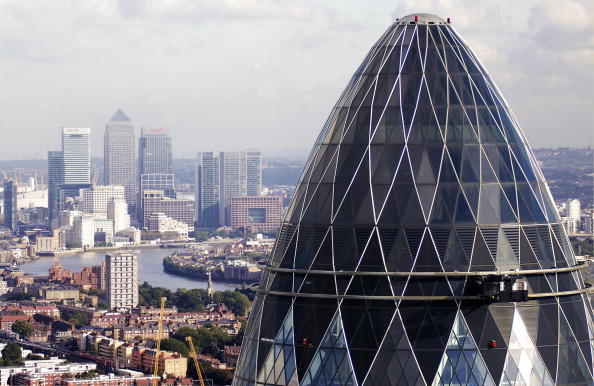Build it better: How the office of the future can help save the planet

Climate change is the headline topic in Davos this week, where business leaders and politicians have gathered for the World Economic Forum.
Activist Greta Thunberg told the gathered elite that their inaction over the climate was “fuelling the flames by the hour”.
While many may dismiss her warnings (President Donald Trump earlier urged leaders to reject the “prophets of doom” such as Thunberg), the issue of how businesses can more efficiently use resources to power our offices — and therefore our economy — is a pertinent one.
To find out how to achieve this, I spoke to three leading companies working to improve the way we light, heat, and design our workspaces.
Light it up
Switching conventional office lighting for LEDs can reduce energy consumption by up to 53 per cent, according to Joao Pola, UK and Ireland chief executive for lighting provider Signify.
“Further advances in lighting technology — specifically switching to LED lights that are part of a connected lighting system — can reduce electricity use by up to 80 per cent,” he adds.
As well as being more efficient, LEDs can be combined with smart systems and sensors so that they turn on and off automatically — which saves energy — and can even tell managers about how well office space is being used.
“With sensors embedded in office light fittings, businesses can collect data on what, where, and how space is being used across their office. For example, managers can see which meeting rooms are most used, which desk areas are left empty, and so on,” explains Pola.
“With this, businesses can then act accordingly to create more efficient workplaces. In 2018, there were 100m square metres of occupied offices in the UK and Wales, but a third were underused — ultimately costing business around £10bn per year.”
Pola even suggests that office lights could be used to boost staff wellbeing.
“Lighting is scientifically shown to affect the human body — through different light recipes at the right time of day, businesses can help boost employee energy, aid concentration, and improve collaboration. For example, cool white light at high intensity promotes focus and concentration, while warmer white light at a lower intensity encourages collaboration and relaxation.”
Of course, having your office manager dictate how bright the lights are could be annoying for some. However, Pola suggests that employees in modern offices can use apps to override the settings and tailor the lighting at their desk to their specific needs.
Getting hot in here
What about heating our offices? Are there more efficient systems than using air conditioning or gas radiators?
Logicor certainly thinks so. The company designs infrared heating systems, which work by passing electricity through panels that emit energy into a room. These panels can generate heat up to 27 feet away.
“It’s a unique type of heat,” explains David Bowen, chief technology officer and founder of Logicor.
“In a normal room, heated by air conditioning or radiators, as is the case with many offices, if you turn off the heating and you’re no longer heating the air, you’ve got to trap that air for an awfully long time and hope none gets out. The reality is that it does, and the room loses heat rapidly.
“But when a wall is confronted by an infrared emitter panel, the room gets warm when it has absorbed as much energy as it can. When you turn the heater off, the wall emits all the heat, like a sponge being squeezed of water — it just falls out. That effect can last up to nine hours.”
Bowen explains that infrared panels can be used to more efficiently heat an office. They could also be built into or above a worker’s desk — meaning that if someone has to stay late, they can be kept warm without having to heat an entire office.
Back to the drawing board
Of course, making truly efficient buildings isn’t just about changing the lighting or heating, but how it is initially designed.
“The starting point for sustainable buildings are passive, low-energy measures such as natural ventilation,” says David Walker, associate director at architects Gpad London. “We’ll make sure that energy efficiency is baked in, so lights that automatically shut off, smarter building controls manage energy needs, and clever design encourages tenants to take the stairs over the lift. Also, we’ll make it easy to cycle to work with showers, lockers, and secure bike storage.”
Other tips include making buildings narrow. This enables cross air ventilation to keep a building cool, as well as making better use of natural light.
“Long-term adaptability is also key, so that the building’s structure can be reused rather than being demolished,” Walker adds. “For instance, designing structural loadings that allow extra floors to be added when the building needs to be re-clad, and having generous floor-to-ceiling heights so that there’s flexibility for different uses.”
These ideas aren’t simply about protecting the environment. Having better designed, energy-efficient offices will reduce a company’s costs and make its workforce more productive. And for cities like London, these measures could offer a competitive advantage.
“People look to London to lead the way,” says Logicor’s Bowen. “If the City starts overtly reducing its carbon footprint, the rest of the world will look on and think, ‘that’s a great thing, they’re heading in the right direction, and we’ll follow what they’re doing’.”
Sign up to City A.M.’s Midday Update newsletter, delivered to your inbox every lunchtime
Main image credit: Getty